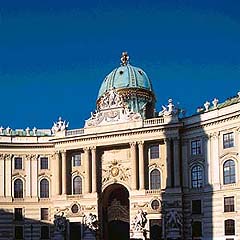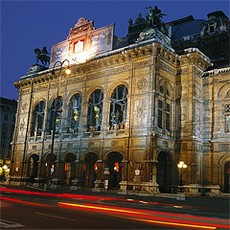
Visit Empress Sisi’s former summer residence. This baroque complex contains an enchanting park, the Palm House, the Gloriette and a zoo. Spend an entire day at Schönbrunn: visit the show rooms with a "Grand Tour with Audio Guide," admire the splendid Bergl Rooms, and stroll through the “Labyrinth.”
Schönbrunn, the former summer residence of the imperial family, is considered one of the most beautiful baroque palaces in Europe. The Habsburgs resided here the better part of the year in numerous rooms for the large imperial family in addition to representational rooms. Emperor Franz Joseph, who later married the enchanting Sisi and reigned from 1848 to 1916, was born here in 1830. The monarch spent his last years entirely in the palace, which became the property of the new Republic of Austria only two years after his death. Today, the palace is part of UNESCO’s cultural heritage due to its historic importance, its unique grounds and its splendid furnishings.
INFO: Schönbrunn Palace
13., Schönbrunner Schlossstrasse
U4: Schönbrunn U4, Tram 10, 58, 60: Hietzing

For more than seven centuries, the great empire of the Habsburgs was ruled from the Imperial Palace. Today, the Gothic Imperial Chapel, where the Vienna Boys’ Choir performs during High Mass on Sunday, is a remnant of the Imperial Palace during the Middle Ages.
In the center of the old city, you can admire the splendor and magnificence of the daily life of the noblest family of the Habsburg monarchy when you visit the private apartments and state rooms. Numerous museums and collections represent the imperial family’s passion for art.
The Imperial Palace, which until 1918 was inhabited by the imperial family, was originally a castle built in the thirteenth century, which was extended to a splendid residence in accordance with the increasing power of the Habsburgs and the expansion of their realm.
Today, the Imperial Palace houses the office of the President of Austria as well as an important congress center and numerous art collections.
INFO: Imperial Palace - Hofburg
U1, U3: Stephansplatz, U3: Herrengasse, U2, U3: Volkstheater,
Bus 48A: Dr.-Karl-Renner-Ring,
Tram D, 1, 2, Bus 57A: Burgring
St. Stephen's Cathedral, Austria's most eminent Gothic edifice, houses a wealth of art treasures, some of which can only be seen during a guided tour:
The red-marble sepulcher of Emperor Frederick III, sculpted from 1467 to 1513 by Niclas Gerhaert van Leyden; the pulpit, a work from 1514-15 by Anton Pilgram (who put his own relief portrait underneath it as his signature); the Altarpiece of Wiener Neustadt (Wiener Neustädter Altar), a Gothic winged altar from 1447 - and the tomb of Prince Eugene of Savoy, dating from 1754.
Tipp: climb the 343 steps to the tower-keeper's room of St. Stephen's and enjoy a breathtaking view...
INFO: Stephansdom
1., Stephansplatz
U1, U3: Stephansplatz
tel. 515 52 - 3526
Mon-Sat 6am-10pm, Sun & pub. hols. 7am-10pm

The Spanish Riding School in Vienna is the only institution in the world where the classic equestrian skills (haute école) has been preserved and is still practiced in its original form. Many years of training fuse horse and rider into an inseparable unit. The audience is treated to an unforgettable experience by the precision of movement of the Lipizzan horses in perfect harmony with the music.
In the course of gala performances, visitors experience unique presentations of the Lipizzans in the most beautiful riding hall in the world, which was impressively outfitted by baroque architect Joseph Emanuel Fischer von Erlach between 1729 and 1735. It was originally built to provide aristocratic youths with the opportunity to take riding instruction.
Morning training with music gives a good impression into the training program of the White Stallions; the guided tours include visits to the stables.
Dates for performances and morning training as well as information on how to obtain tickets at www.srs.at.
INFO: Spanish Riding School
1., Michaelerplatz 1

The Vienna State Opera is one of the top opera addresses in the world – where you can enjoy the very best in first-class productions. This famous stage offers a different program every day, with over 50 operas and ballet works on around 300 days per season.
INFO: Vienna State Opera
Opernring 2
1010 Vienna

From 1940 - 1944 Hartheim Castle in Alkoven (Upper Austria) was in use as a Nazi euthanasia site. During this time, around 30.000 physically and mentally handicapped people, some residents of care homes, others imprisoned in Mauthausen, Gusen, Ravensbrück and Dachau concentration camps and deemed unfit to work and forced labourers were brought here and murdered. In 1995 the Hartheim Castle Society was founded. Its aim is to create a suitable place of remembrance and provide a social discussion platform. In 1997 the Upper Austrian regional Government made the decision to renovate the castle. After renovation, a memorial to the victims of the Nazi euthanasia programme was erected in 2003 and the "Value of Life" exhibition created. This was to become the "Education and Memorial Site Hartheim Castle".
Steeped in a sinister history, the castle is a place for reflection on the consequences and impact of the National Socialist euthanasia and eugenics programmes. The aim is firstly to present the documentation of the events themselves and secondly to portray the concepts and thinking behind the programmes as such ideas that are all to ready to resurface in whatever form.
Central to this theme is the idea that social problems can be eased through the manipulation of natural science, that is to say, "biological intervention". Biological solutions promise straightforwardness instead of the often incredible complexities of social debate and so regularly gain popular interest. During a guided tour you will see the memorial site and the exhibition „Value of Life“. The purpose of the exhibition and memorial site is to encourage the discussion of historic and current issues.

Conceived of as an exhibition site for the art form Art Brut, museum gugging displays the works of the Gugging artists at their place of origin and at the same time functions as a forum for international Art Brut as well as contemporary art in general. French painter Jean Dubuffet, who coined the term Art Brut, meant by it “sopisticated, raw, original art“ of a highly personal and unadapted form of expression. Uninhibited by trends in established art, Art Brut is created by artists without any background in academics or art theory.
The Museum‘s standing exhibition displays masterpieces from the Private Foundation - Gugging Arists on an area of 840 sq yd. The exhibitions about the art from Gugging, from 1960 to the present, include important works and offer a comprehensive overview of the history and presence or artistic activity in Gugging. The second half of the Museum is a venue for changing exhibitions. Works by international Art Brut artists are prevalent here nex to art from Gugging. Furthermore, other artistic positions enter into dialogue with Art Brut.
![]() http://www.gugging.at
http://www.gugging.at
Discovering Art!
"...We wish to get as many people touched and inspired by art as possible. Exploring new and undiscovered art, and getting in touch with your own creativity enriches your life and sets free innovative power. Art is a life essence... With that in mind we want to positively contribute in developing society."
The Collecting Couple Agnes and Karlheinz Essl
Opened as a private collectors museum in 1999, the Essl Museum, has evoled throughout 14 years into an internationally recognized and appreciated location for contemporary art. The foundation for all the exhibitions in the museum is a collection consisting of over 7.000 pieces of international contemporary art. From the beginning, Agnes and Karlheinz wanted the museum to be a lively open house for art and it's important for them that art is accessible for everybody. They found new ways to offer a broader spectrum of possibilities and individual approaches to contemporary art.through exhibition programs and the presentation and communication of art.